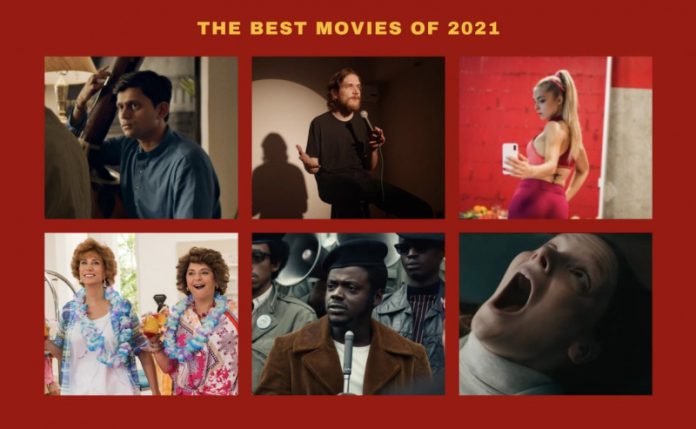Artnewspress :
These may be strange times for the movie business, but the art form is doing just fine.
Movie theaters are reopening and audiences are creeping back, but that’s only part of the story. As with last year’s shocking changes to the media landscape, no amount of shutdowns and shifting distribution paradigms could stop movies from getting out there, whether they came to small VOD entities or the biggest streaming platforms. And while the “movies versus TV” debate rages on, the cinema one hasn’t.
This year’s release calendar has been so loaded with feature-length wonders, many of which push the boundaries of art form, that even at this midpoint, our usual edict remains intact: Anyone who thinks this has been a bad year for movies simply hasn’t seen enough of them.
Our list of the best movies of the year so far follows the same basic rules: In order to qualify, a film must have been released in North American theaters for at least a week or on a VOD platform in the same territory. That means we’ve got the usual festival leftovers from last year that finally made their way to audiences alongside a handful of titles that materialized in recent months. It also means that we can’t include movies we’ve already seen and adored that haven’t been released, even if they’re right around the corner, from documentary crowdpleasers like “Roadrunner” and “Flee” to innovative rides like “Zola.”
Fortunately, with Cannes around the corner and the fall festivals not far behind, this finite collection of highlights will have many reasons to grow by the end of the year. Make the effort to see what you can now and stay tuned.
“About Endlessness”
There’s something amusingly dry about the idea of a 76-minute film called “About Endlessness,” but Roy Andersson isn’t joking. Well, he isn’t only joking. A Swedish renegade whose pointillistic dioramas of the human condition are pieced together with drollness in much the same way as George Seurat’s landscapes were painted with dots, Andersson has always been amused by the sheer absurdity of life on Earth. But if even the title of Andersson’s latest feature sounds like a wry gag, it’s also meant to be taken at face value.
The least funny and most tender movie that the “Songs from the Second Floor” filmmaker has made since building his own studio with the profits he’d saved from decades of enormously successful commercial work, “About Endlessness” adopts the same qualities of life itself: it’s both short and infinite. It’s over in a heartbeat, and yet it feels like it could go on forever. There are scenes of absurdity, and scenes of loss. There are scenes of pain, and — in a far more pronounced way than in any of Andersson’s previous films — scenes of joy.
On a long enough timeline, these various episodes will all be flattened out into the same minuscule size. And yet, even in the moment, Andersson has already rendered them with almost equal importance. Like a stone-faced Scheherazade, Andersson stops as soon as it’s clear that he can outlast us. —DE
“Barb & Star Go to Vista Del Mar”

“Barb and Star Go to Vista Del Mar”
Cate Cameron/Lionsgate
It seems odd to deem any film an instant cult classic, but “Barb and Star Go to Vista Del Mar” is such a giddy outlier, a dense, flawed assemblage of zany humor that people will happily tear into for years to come. Bumps and all, “Barb and Star” is a wholly unexpected combination of “MacGruber,” “Pop Star,” and “Despicable Me” (yes, really) that operates entirely on its own wavelength. Fortunately, most of that wavelength has hysterical results, resulting in an eager-to-please package that tosses off lines designed to inflict maximum comic damage (a gag about “fried bald eagle babies” is impossible to contextualize, but it’s the sort of thing that left this critic gasping for air) before zipping right along to another wacky new set piece.
Kristen Wiig and Annie Mumolo, who both wrote the film and star in it as the eponymous Barb and Star, seem understandably thrilled to bring this nuttiness to life. The pair reportedly cooked up what would become Barb and Star — good-natured BFFs from “Soft Rock, Nebraska” who have never left their small town — while making “Bridesmaids,” first imagining the inseparable duo as a single character (allegedly Maya Rudolph’s character’s mom) who delighted in her seemingly common life.
But while that sounds like the sort of thing ripe for cheap jokes and mean jabs, Wiig and Mumolo have an obvious affection for their BFF avatars, and Barb and Star’s fidelity to their bond is the film’s one immutable element. Both a loving ode to friendship, an excuse to learn all about Jamie Dornan’s truly excellent singing ability, and the rare comedy that seems destined to have the same staying power as the otherwise peerless “Bridesmaids.” —KE
“Bo Burnham: Inside”

“Bo Burnham: Inside”
We know what you’re thinking: a comedy special on a list of the best movies of the year? But look, if you’ve seen “Bo Burnham: Inside,” you know that “comedy special” doesn’t exactly cut it. With its 90-minute running time and freewheeling experimental arc, Burnham has essentially crafted a microbudget movie about the last man on Earth coming to terms with a reality that has already slipped beyond his grasp. Quarantined and disheveled from the first scene, he careens through oddball melodies and monologues about modern times, resulting in a hilarious crisis of consciousness gone wild.
How do you craft escapism when escape is no longer an option? Burnham turned the camera on himself. The lanky comedian-turned-filmmaker has been delivering wry musical standup work since his teen years, but the pandemic forced him to reconsider his approach. While “Bo Burnham: Inside” has been billed as a surprise Netflix comedy special from a guy who has made a few them, it’s actually a far stranger and profound feature-length immersion into the anxieties of a year when the very idea of a “comedy special” sounded like a lost cause. The result is more Charlie than Andy Kaufman, as “Inside” becomes less about messing with the audience than plunging them into the contours of Burnham’s conflicted mind, mining brilliant and scathing observations in the process.
Burnham wrote, directed, edited, and starred in this minimalist musical fantasia, shot exclusively in his home in Los Angeles over the past year, and the result is an impressive one-man technical feat loaded with surreal twists and dense commentary under the veneer of sophomoric gags. Just above his charming grin lurks an eerie stare, and the ensuing ride lingers between those two extremes, as Burnham comes mighty close to amusing himself to death. He may be conflicted about the world these days, but there’s much to glean from watching him make sense of it. —EK
“The Disciple”

“The Disciple”

“The Disciple”
Northern Indian classical music sounds like nothing other than itself: The jangling of the sitar and the meditational warbling of the improvised vocals known as raga have a profound ancient quality that taps into the mystery of human existence. Ravi Shankar may be the name most closely associated with popularizing such melodies in the West, but the art form (known as Hindustani music) extends well beyond the accomplishments of one man. That’s the hard truth faced by Sharad (real-life musician and acting newcomer Aditya Modak) in Chaitanya Tamhane’s brilliant sophomore drama “The Disciple,” the story of an idealistic young performer who dreams of capturing the magic of a musical traditional that he may lack the talent to achieve himself. In Tamhane’s dreamy, transcendent character study, the undulating raga melodies serve as a transformative portal to self-discovery that places the audiences in the confines of its entrancing power.
“The Disciple” follows Tamhane’s stellar first feature, “Court,” which also looked at the complex role of music in Indian society, in that case through the lens of a corrupt judicial system. Here, the music that Sharad adores take on a more personal connotation, as the man contends with the provincial nature of his vocation in a world that waits for no one. Taking cues from his wizened mentor (veteran singer Arun Dravid), Sharad dreams of obtaining high marks as a classical music vocalist, absorbing enthusiasm for the process from his late father.
But there’s a reason only an elite few manage to excel at the rhythmic, transcendental wailings of the raga, and it doesn’t take long to see that Sharad might not have the right stuff. “The Disciple” unfolds in slow, melancholic rhythms on par with the music at its center. Set against Mumbai’s bustling cityscape, a backdrop at violent odds with Sharad’s contemplative vocation, the movie follows the character through three distinct eras as he grows older and continues to internalize his frustration. The movie is more about the journey than the destination, with a conclusion that suggests the student never really becomes the teacher when the subject is his own life. Cinema is rarely this relaxing and revelatory all at once. After it was denied the slot of its country’s Oscar submission, “The Disciple” landed quietly on Netflix earlier this year, and the small screen can’t fully encapsulate the sonic wonders it offers up. But it’s a start, and well worth a look. —EK
“In the Heights”

“In the Heights”
Macall Polay
So exuberant and full of life that it would probably convince you the movies were back even if they hadn’t gone anywhere, “In the Heights” is the kind of electrifying theatrical experience that people have been waxing nostalgic about ever since the pandemic began — the kind that it almost seemed like we might never get to enjoy again. Seeing this massive, guileless, heartfelt piece of Hollywood entertainment on the big screen is like coming home after a long year in exile only to find that it’s still there, and maybe even better than you remembered. In that sense, Jon M. Chu’s super-glossy adaptation of Lin-Manuel Miranda’s other Broadway smash lands with equal parts rapture and relief. If only anyone had gone to see it.
Despite the Pro Bowl team of Monday morning quarterbacks who were eager to explain what happened, the box office failure of “In the Heights” remains the year’s biggest head-scratcher. But some movies are simply too full of life to fade away after a few bleak weekends, and Chu’s full-throated (if controversially incomplete) celebration of Washington Heights’ Latinx community is such a propulsive ode to “a people on the move” that it makes you feel like its characters are dreaming with their eyes open. It’s also the rare bomb that deserves to produce at least three genuine movie stars, as Anthony Ramos, Melissa Barrera, and Corey Hawkins are so damn radiant that you’d swear Cassiopeia shines over Washington Heights after all. —DE
“Judas and the Black Messiah”

“Judas and the Black Messiah”
Warner Bros/Everett Collection
Fred Hampton is looking for revolutionaries. William O’Neal is trying to stay out of prison. In Shaka King’s vivid “Judas and the Black Messiah, these seemingly very different men will be set on a terrible collision course for each other. One part Hampton biopic, one part unnerving portion of American (and all-too-recent) history, King’s drama is a nuanced portrait of a people, a place, and a betrayal that has never before received such a full telling. Bolstered by major performances by eventual Oscar winner Daniel Kaluuya (as Hampton, the visionary chairman of the Illinois chapter of the Black Panther Party in the late ’60s) and Oscar nominee Lakeith Stanfield (as O’Neal, an FBI informant who infiltrated the BPP and Hampton’s inner circle), “Judas and the Black Messiah” makes the Hampton saga feel as urgent — and tragic — as ever.
King, directing only his second feature film, deftly handles the complex script he co-wrote with Will Berson from a story by the Lucas brothers, Keith and Kenneth, one that layers time, place, perspective, and mood. At every turn, “Judas and the Black Messiah” doesn’t just allow the space to consider the motivations of both its primary characters, but actively seeks out those shades of gray. Fred is a blazing visionary who routinely calls for nothing less than a total overthrow of American politics, but he’s also a tender soul who gets skittish around the girl he likes and is the first person to show up to comfort a grieving mother. William is a rat and a snitch, the kind of guy who revels in the spoils his ill deeds earn him, but also demands justice for a fallen brother. There are no easy answers here, but that only makes it feel all the more real. —KE
“The Killing of Two Lovers”

“The Killing of Two Lovers”
With a movie called “The Killing of Two Lovers,” one might know what to expect from the start, but Robert Machoian’s gripping thriller plays off the prediction of its title at every riveting moment. David (a disheveled Clayne Crawford) is already at wit’s end as the movie begins, hovering over his estranged wife (Spideh Moafi) and her new boyfriend as they sleep in their small-town Utah home. A gun sits in his sweaty hand, but he has yet to pull the trigger.
From that unnerving start, the movie drifts through David’s fragile existence, as he makes repeated attempts to reconnect with the love of his life and their four children, juggling his simmering rage with the semblance of sanity still percolating in his head. This material could turn melodramatic at any moment, but Crawford’s jittery performance and Machoian’s naturalistic style joins forces with an ominous sound design that brings the fragility of its protagonist’s mindset to life. The result is a fresh and bracing new look at the dissolution of the American family that redefines edge-of-your-seat filmmaking through the sheer talent on display at every moment. —EK
“Saint Maud”

“Saint Maud”
A24
An unholy cross between “First Reformed” and “The Exorcist,” Rose Glass’ taut and trembling “Saint Maud” transmutes a young woman’s spiritual crisis into such a refined story of body horror that watching it almost feels like a religious experience. A palliative care nurse in a dreary town somewhere along the British coast, the intensely devout Maud (a divine Morfydd Clark) is doing her best to seal the area around her soul. That seems to be one hell of a struggle. Soft-spoken but vibrating with serial killer intensity, Maud seldom opens her mouth when she’s not talking to God inside her acetic little apartment, and reminding her lord and savior that she was meant for something greater. Maud’s bitter new patient (Jennifer Ehle) doesn’t, uh, share quite the same faith.
Like most secular films about the fervor of devout religious faith, Glass’ severe and wickedly crafted debut feature is wary of its protagonist’s conviction; “Saint Maud” isn’t in a hurry to define its terms, but there’s no mistaking that Maud is a horror movie unto herself. She’s like if the alien from “Under the Skin” disguised herself as a nun. Is it really possible that one of those voices belongs to God? Will Maud be granted a ticket to heaven if she can save her patient’s soul? Glass refuses to hedge her bets. In her own way, the filmmaker is as much of a hardliner as her heroine, and “Saint Maud” is all the more terrifying for how it refuses to back down from its truth. —DE
“Sweat”

“Sweat”
MUBI
There are some movie characters who take their time to cement themselves onscreen, but Sylwia Zajac (Magdalena Kolesnik), the celebrity workout instructor and social media fiend at the heart of “Sweat,” establishes herself in a matter of seconds. Speeding through a rapid-fire workout routine in the zippy opening sequence of director Magnus von Horn’s taut and emotional character study, Sylwia wears a frozen grin as she moves through an energetic physical routine for a boisterous crowd as the camera swoops around her. There’s an inherent sensuality to Sylwia’s breathless assemblage of planks and pushups, but the balletic display buries the essence of the person beneath the surface. Her face tells a different story, with wide eyes hinting at the anxious, fragile human she’s struggling to contain for the cameras. “Sweat” evaluates that struggle as it pushes Sylwia to a breaking point.
The most intense look at a social media-obsessed loner since “Eighth Grade,” Swedish director Von Horn’s Polish-language feature finds its character wrestling with the nature of her popularity, until she’s forced to confront the disconnect between her public and personal existence in vivid detail. A dazzling figure who thrives on sharing her beauty with the world, Sylwia has boxed herself into a superficial universe of her own design. —EK
“Test Pattern”

“Test Pattern”
Kino Lorber
First-time feature filmmaker Shatara Michelle Ford squeezes a lot out of 82 minutes. In “Test Pattern,” a perceptive and often quite painful examination of sexual assault, relationship dynamics, racial divides, and the corrosive power of violence, the writer and director mines a dizzying amount of topical issues, tying them all up as a compelling two-hander to boot. Despite the density of their subject, Ford avoids heavy-handed platitudes and dramatic tropes, instead relying on a strong script and a pair of sneakily powerful performances from stars Brittany S. Hall and Will Brill.
Weaving back and forth in time, “Test Pattern” opens on the incident that will drive the bulk of the drama’s action: a woozy Renesha (Hall), still somehow managing to sit upright on a bed, a glass of water threatening to tip out of her hand. She’s not alone, and when Mike (Drew Fuller) comes into frame, Renesha’s dulled senses might not instantly realize the threat, but Ford’s invasive lensing of the interaction instantly puts the audience on alert. The discomfort of that scene will stay with both Renesha and the audience, as “Test Pattern” takes us through the events that led to the encounter, and everything that came after.
The next morning, Renesha and her boyfriend Evan (Brill) motor around Austin in search of a rape kit (like “Never Rarely Sometimes Always,” “Test Pattern” is a sterling reminder that many female-centric health care is often impossible to obtain), the film makes a sly transition into a drama less about Renesha’s personal trauma, than a wider-ranging look at the absolute dehumanization that seems to accompany bureaucratic matters. There are many moments in “Test Pattern” that might inspire rage in its audience, but none so affecting as the repeated lack of concern that follows a request for a rape kit. The person in need of it, who requires the minimum of care and compassion, rarely gets that. —KE
“There Is No Evil”

“There Is No Evil”
“There Is No Evil” spends 30 minutes establishing its premise, and another two hours taking it in surprising new directions. Iranian director Mohammad Rasoulof’s brilliant anthology feature, which won the Golden Bear at the 2020 Berlinale before finally opening in North American this year, moves in so many unexpected directions that it remains impossible to pin down until the credits roll. The movie unfolds across four stories about military men tasked with executions as they grapple with their options, contend with the fallout, and witness the impact it has on the people closest to them.
Rasoulof, who has been barred from leaving his country since 2017, has made an absorbing ride defined by the paradoxes of its people. Nobody in “There Is No Evil” has it easy: There’s no simple moral code when every possible option leads to a point of no return. —EK
“The World to Come”

“The World to Come”
Bleecker Street
As coldly drawn as an atlas yet no less capable of enflaming the imagination, Mona Fastvold’s “The World to Come” is a hard and brittle period love story that thaws into something much warmer — what its hyper-literate heroine would call “astonishment and joy” — as a merciless 19th-century winter blushes into a most unexpected spring.
The story is set in upstate New York circa 1856, where Abigail (Katherine Waterston) mourns the daughter who was taken by diphtheria a few months prior, and journals about a world that feels barren in the young girl’s absence. “With little pride and less hope,” she writes, “we begin the new year.” And what a new year it turns out to be. It starts with new neighbors, including the comely Tallie (Vanessa Kirby) and her sulking husband (Christopher Abbott). It blooms with new memories. And it shudders with the tectonic aftershocks of a woman who — with no means of escaping her nook-like place in the world — dares to remap herself. Fastvold’s knockout may be so withholding that other “restrained” lesbian romances seem as if they’re sky-writing their emotions by comparison, but “The World to Come” so masterfully entwines the furtive eroticism of “Portrait of a Lady on Fire” with the kerosene ache of “The Assassination of Jesse James by the Coward Robert Ford” that it finds its own way to convey the sweet vertigo of falling in love. —DE











![Erin Lee Carr on ‘I Love You, Now Die,’ Her Favorite Documentaries, and the Essential Elements of Great True Crime [Interview]](https://artnewspress.com/en/wp-content/uploads/2019/10/i-love-you-768x432-100x70.jpg)











